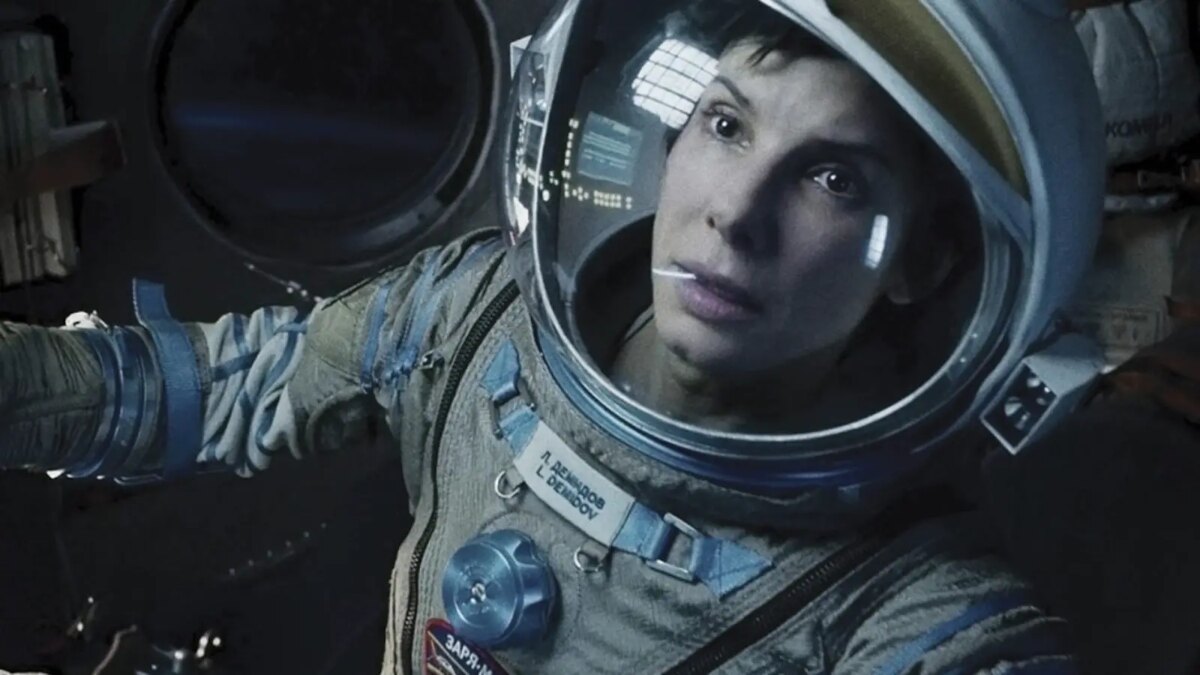
Once you start geeking out about solar you start to see panels just about everywhere you go – from the top of bins to the sides of skyscrapers and more.
One thing I have started to do recently is spot them in the films and TV shows I’m watching. While it amuses me, I’m not sure my friends are at all impressed when I suddenly shout, ‘There’s no way those panels would be producing enough electricity to run that fun fair!’
So, after discovering the fantastically simple ‘Is There A Cat In The Movie?’ Twitter account, I have decided to get it out of my system by writing an ‘Is There A Solar Panel In This Movie’ kinda blog.
Let’s take a look…
Blade Runner 2049 (2017) and Sahara (2005)
One of the pivotal scenes in 2004’s action-packed dessert turkey, Sahara, shows Matthew McConaughey and Penelope Cruz fighting for their lives atop of a solar tower.
While the wonders of CGI make the installation look super real, there isn’t an actually thermal solar farm in the Sahara Dessert, which is absolutely baffling. This is not the only time this kind of installation features in the movies though.
The over-long sequel to the 80s classic Bladerunner may be set in 2049, but it still opens with a long, tracking shot showcasing a massive Thermal Solar Farm. Admittedly it’s way bigger than anything we can see on the planet right now, but thermal solar farms are very much a 2023 kinda thing and the one in Bladerunner 2049 is based on The Ivanpah Solar Electric Generating System (ISEGS).
Unlike the photovoltaic solar farms we are used to seeing, the Ivanpah uses huge mirror arrays to focus the sun’s heat on a central Solar Power Tower. The heat is then used to boil water until it becomes highly pressurised steam that can drive a specially designed turbine.
The question is, why do the makers of Bladerunner think this tech will not only be around in 2029, but will be thriving? Solar Thermal Towers are a hugely inefficient way of making electricity using the sun as they take up massive amounts of land. In a world that has people living in small, cramped cities such as the one showcased in the classic, original Bladerunner, you’d think they’d be generating all their electricity in a much more space-savvy way.
The Martian (2015)
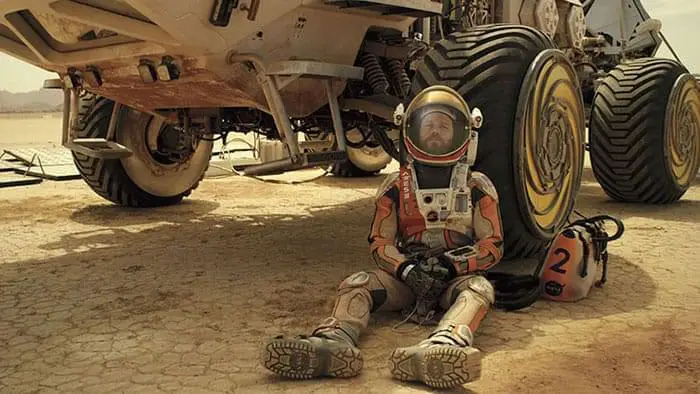
Possibly one of the best sci-fi movies out there, and one the scientific community doesn’t criticise too much, is 2015’s solitary space drama, The Martian. Based on the 2011 book by Andy Wier, it tells the story of an unfortunate Astro-adventurer getting stranded on Mars after the ship he was supposed to go home in has to lift off early in a dust storm.
We can just gloss over the fact Mar’s atmosphere isn’t thick enough to create a dust storm strong that would ground a spaceship and move straight on to surviving, thriving and gardening on Earth’s closest cousin. Apparently, the groovy boffins at NASA let the film’s designers, writers and crew study the tech they use to launch un-manned missions to the Red Planet.
So, some of the equipment, gadgets and ideas Matt Damon’s characters uses to survive are actual, real things. One of which is, of course, solar panels. Any mission beyond Earth would need power sources of all kinds to keep going and solar has been used in space exploration since the 1960s.
However, using solar on Mars presents its own problems. Mars is 142 million miles from the sun, compared to the earth’s 92 million, but the atmosphere on Mars is much, much thinner than Earth’s so more of the light spectrum can make it to the surface of the planet. The amount of sun hitting a planet’s surface is called irradiance and the irradiance on Earth is around 1000 watts per square meter, on Mars it is 590 watts per square meter.
So, flexible solar panels could very easily provide the power needed to power a human settlement on mars – once we work out all the other problems of living on a dead planet!
Wall-E (2008)
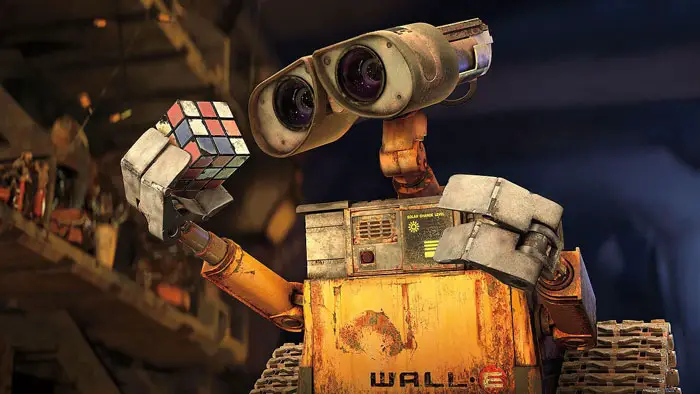
Wall-E is possibly one of the cutest, most universally loved movies from the Pixar/Disney stable – and the eponymous star is powered by solar. When he starts to run low on power, this cute little garbage collector whips out a foldable PV panel and charges himself up. Wall-E’s lot seems a sad one, as he is programmed to clean up the mess left behind by the humans who had to leave because … well, because of the mess!
The idea is Wall-E has been alone for nearly 700 years … so what is he charging up?
Currently, even our most advanced batteries only last a decade or so … if we could invent a battery that would charge, and discharge, for that long we would be able to afford our own Wall-E! The sun will still be providing 1000 watts per square meter in 2805 so Wall-E’s little panels would be able to charge a battery, but those batteries would have to be fuel cells. A fuel cell, according to Study Mind, ‘… is a device that generates electricity by using a chemical reaction to convert fuel and oxygen into electricity, heat, and water.’
Fuel cells are currently being used in solar systems across the globe to it’s not totally impossible Wall-W is stuffed with them.
Mind you, once Wall-E teams up with EVE, she’ll be able to upgrade his power system.
James Bond: The Man With The Golden Gun (1974)

The world’s most famous gentleman spy isn’t someone we’d immediately associate with renewable energy … and he wasn’t! It was his nemesis Scaramanga! The Man With The Golden Gun is a very forward-thinking movie for is time, as the plot revolves around Bond trying to stop Christopher Lee’s character from killing a prominent solar scientist who is trying to save the world from an imminent energy crisis.
The film takes inspiration from the 1973 Oil Embargo that the Middle Eastern States placed on exporting to the USA, ramping up energy prices and creating a fuel deficit – sound familiar?
Anyway, the fictional solar cell in this film is an answer to the world’s problems and it’s called a Solex Agitator.
It is a cell with a 95% efficiency rate … which is nearly 5 times more efficient than modern panels today, over 3 decades after the film was released. Scaramanga is something of a precursor to today’s billionaire oligarchs, developing his own tech for personal gain and, if possible, world domination.
That said, he does have solar panels and full solar power station on his secret island liar, so at least he’s a green meanie!
Sunshine (2007)
Danny Boyle’s brilliant foray into the Sci Fi genre was, pretty much, the ultimate film about solar energy.
The sun is dying and so is Earth, no one is able to grow food or stay outside for long, let alone reduce their bills using PV technology! Cillian Murphy is the genius physicist who has created a stellar bomb to ‘re-ignite’ the sun and, although Murphy consulted with real-life, floppy haired genius physicist, Brain Cox, that part of the storyline is pure fiction.
What isn’t fiction, or at least based in reality, is the solar shield used to protect the Icarus 2 from the sun as they approach to drop the payload into our star’s core. The sun may be dying in this film but it is still kicking out a serious amount of heat, meaning the shield would behave in the same way thermal solar mirrors work by directing the sun’s harmful rays in a particular direction – in this case, away from Murphey and his band of misfits.
There is no mention of powering by solar in Sunshine, but as the sun is dying, it’s probably not a tech they could be confident in using.
Gravity (2013)
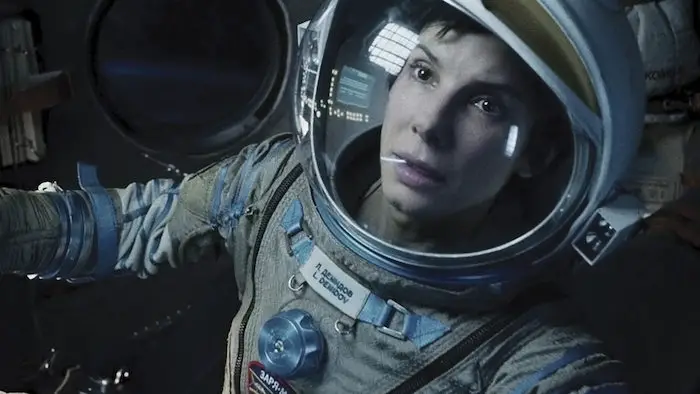
Gravity is one of the more realistic and believable films on this list and, though it may be far-fetched, it’s not completely beyond the realms of real science. George Clooney and Sandra Bullock play a pair of experts who board the space shuttle and set off to Earth’s orbit in order to make repairs to the Hubble telescope.
Unfortunately, and this is some real theoretical science, they are stranded when their shuttle is destroyed by debris travelling at deadly speed round the Earth’s orbit after a satellite is blown up … the process of debris hitting other satellites and space furniture is called the ‘Kessler Effect’. So, what’s this got to do with solar? Well, firstly, the Hubble telescope is entirely powered by solar.
Hubble is currently on its 3rd set of wing-like solar arrays, which were fitted in 2002, and the cells are made using gallium arsenide (GaAs) which are more efficient than their silicon counterparts. Despite being smaller than their predecessors, these arrays produce 20 percent more power and, due to their size, reduce the amount of atmospheric drag on the telescope. As the ISS Space Station is Bullocks savior, we should probably mention this is powered by solar as well. Again, large, retractable solar wings power the station.
They are the largest ever deployed in space and weigh over 1.09 tons – each one featuring over 33,000 8-cm square solar arrays over 2 ‘solar blankets’. They reach out 35 metres and are 12 metres wide, generating nearly 31 Kilowatts of direct current power. When the blankets aren’t in use, they are safely folded away into box just 51 cm x 4.57 metres!
There are 8 of these wings and, altogether, they generate about 240 kilowatts in direct sunlight.
Transcendence (2014)
Solar in films was starting to get harder to find without repeating myself by this point but, looking hard, I stumbled on the almost-forgotten Jonny Depp vehicle, Transcendence. Now, this is not a career highlight for everyone’s favorite pirate, and it wasn’t exactly teaming in awards and critical praise, but it does feature solar in a very real and practical sense. And it’s all about AI, which seems a pretty relevant subject at the moment.
Depp’s character is a super-scientist that manages to merge his brain with a mega-advanced AI program – eventually making him omnipresent and invisible.
But how is Edward AI-Hands powered? Solar of course. The crew built an entire solar farm in the dessert in New Mexico and managed to face all of the panels the wrong way! Pointing the right way, these polycrystalline panels would easily be able to power Depp’s PC based personality … but he’d have to save the planet and the girl during daylight hours.
The Walking Dead (2010 – 2022)

If you can’t find yourself some solar panels during a zombie apocalypse, you’re going to struggle! Luckily, Rick Grimes and his band of cool looking survivors seem to find them just about everywhere they go. The Govenor has them all down the middle of the main street in Woodberry plus there are panels all over Alexandria and Hill Top.
Solar seems the perfect solution once the world goes to pot as panels can produce power for decades and they tend to be ‘plug in and play’ technology. Rick and the gang certainly couldn’t start knocking out panels in their garages, so they’d have to scavenge for panels and, if the Walking Dead was set now, there would be an abundance of solar panels laying around.
In 2022 Solar power in Virginia, where The Walking Dead is set, was estimated to be able to provide 32.4% of all the electricity in the state. However, Rick wakes up in that hospital in 2010, when Virginia had only one roof top with the capability of producing 10 to 20 kW, so he’d have to look at homesteads, farms and smaller domestic installations.
Inception (2010)
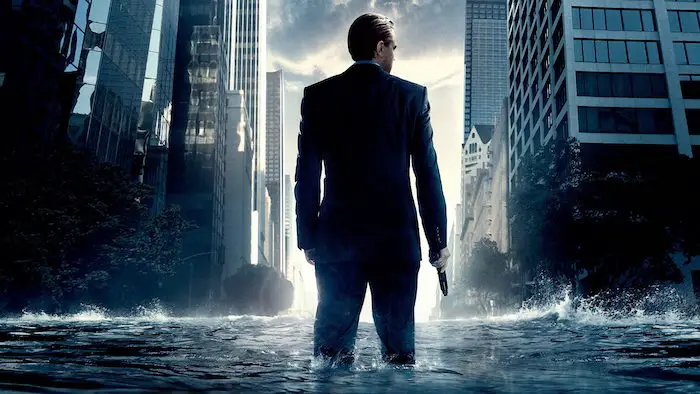
Inception is receiving a special mention because there are no solar panels in the film … or maybe there are but I was too confused to notice. No, we are mentioning this because the main star, Leonardo DiCaprio, suggested powering the film using renewable energy.
Dicaprio told the Philippine Daily Inquirer: “A lot of this movie was made with solar power. It’s the first movie I got to do with solar power. I had a conversation about it with Alan Horn, who’s the head of Warner Bros. The generators that we had on the set were all powered by solar energy. It’s going to be a big conversion to do stuff like that every day, not just in making movies but everything in the world.”
It was actually the ‘base camp’ that was powered by solar, and these usually take up 10 – 20% of the whole film’s power consumption. The power came from generators outputting 600 amps/72,000 watts of ‘pure sine wave power with no noise, and no emissions’ according to Pure Power’s website. It’s not much, but it’s a start!














